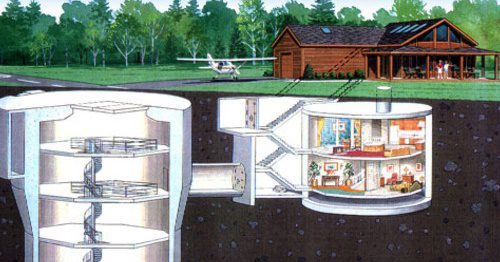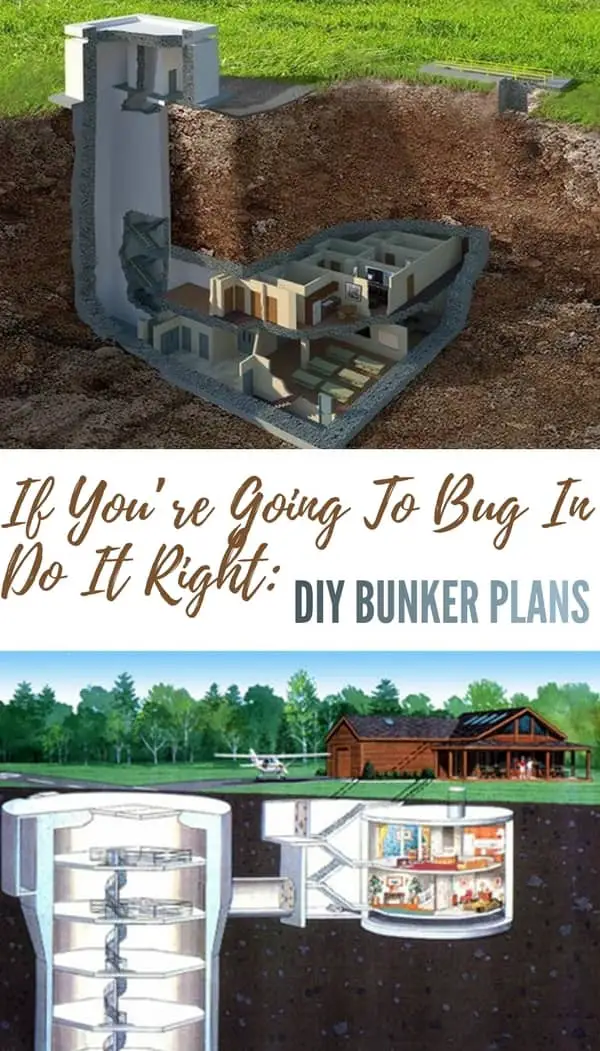DIY bunker plans can be an ideal option for building a disaster bunker. Most people think disaster bunkers are out of reach due to finances or lack of space. Fortunately, there are options.
What I want to focus on today is the disaster bunker, which is widely thought to be out of reach for most either financially or space-wise.
This article will go over a few ways you can achieve the goal of having a survival bunker by using DIY bunker plans.

I won’t lie to you. Bunkers can cost a lot of money to build. But if you’re willing to invest the money, the time, and effort, a DIY bunker can be achieved. There are underground bunker kits that can make this entire process easier for you.
There are many companies that will offer you a decent price for a quality bunker. One thing to be careful of is they will try to lure you with credit. If there is one thing that stifles disaster preparedness, it’s the influx of debt.
Be sure that you take your time and be smart when considering your direction for building a bunker. Here are some things to keep in mind.
Why You Need a Bunker
Before you get started, it’s important to consider all of the reasons an underground disaster bunker is worth investing in. DIY bunkers are life-saving during any of the following scenarios:
- World War III
- A nuclear war
- TEOTWAWKI (The end of the world as we know it)
- An apocalypse
Having an affordable underground bunker during any of these scenarios will give you the upper hand over someone without a bunker. Bunkers also make great arsenals for stockpiling food and other supplies.
Some people also use DIY underground bunkers during bad weather conditions, such as tornadoes. Bunkers can also act as safe rooms, especially if you have underground tunnels connecting your home to the bunker.
DIY Bunker Plans
It should be known that this isn’t going to be a weekend project that can be knocked out in a few hours. This is going to take real planning, and it would be suggested to have an outside perspective if possible. However, there are a number of resources out there you can take advantage of.
First, you’ll want to consider where to build your bunker. Although your own property might be the first thing that comes to mind, you’ll want to make sure you’re not in violation of any city ordinances. You might need to purchase property to build a bunker on.
You’ll want to seek trustworthy professionals when it comes time to build your bunker. Whether you decide to work with a dyed in the wool bunker company or bring in the help of an engineer, it is all going to have some cost. It’s worth noting that the cost may be significant.
Be sure to budget for this project and be sure you tell your loved ones about it as well. They will want a say in the planning and layout of your DIY bunker plans.
Building the Perfect DIY Bunker
There are a number of things to keep in mind when coming up with your DIY bunker plans. There are certain things that every underground bunker will need.
Here are some of the essentials for your DIY bunker:
Discreetness
It’s recommended that you choose a good hiding spot for your bunker in the event of a survival situation. Hiding the entrance with trees and bushes can help keep it hidden.
Ventilation
Having a good supply of oxygen is important when you’re living or spending a significant amount of time underground. It’s important to research the best ventilation system for your bunker.
Water Supply
Your underground bunker needs a supply of water. You might be able to build an underground water supply system, but if not, you might consider building a rainwater collection system to harvest water.
Electricity
It’s most ideal to have electricity in your underground bunker, so you’ll need to hire an electrician. However,
If you plan on being down there a long time, you will want to have electricity in your underground bunker. A self-sustaining source, like solar, would be ideal if you can manage it. However, you will have to plan on how to hide the panels, as a bunch of solar panels will reveal you as a target after SHTF.
You will ultimately need to consider the consequences of not having electricity at all, and plan for that fact. You won’t be able to count on the local utility company to continue to function after a major disaster and the subsequent fallout.
Sanitation
You’ll need to consider what type of sanitation system you’ll have in your underground bunker. It’s possible to have either a septic tank with full plumbing or a holding tank. While holding tanks can be difficult to empty, septic tanks are at risk of blasts during a disaster.
Designing Your Underground Bunker Floor Plans
Before you start building, you’ll want to design your bunker’s floor plans. It’s important to give a lot of consideration to what you really want before you draw the blueprints. The possible floor plans for a DIY bunker are endless.
You’ll want to make sure that you have enough space in the bunker for your entire family. If you have many family members, you might consider using bunk beds to best utilize your space. You might also need to add an extra bathroom, if necessary.
You will want to make sure that you include enough space in the bunker for storing food and other survivalist supplies. You’ll want to be able to store, at a minimum, 3 days’ worth of food at any given time. It’s better to be able to store even more than that, however.
When designing your DIY bunker plans, it’s important to keep in mind that comfort is key. You’ll want to allow yourself as much space and as many rooms as you can. It’s even possible to have multiple levels on your underground bunker if you choose.
Getting Started on Your DIY Bunker
Once you have a location for your bunker, it’s time to start digging. You can dig with a shovel or you can rent heavy equipment to make the job go quicker.
The next thing to consider for your DIY bunker plans is what type of structure to use. A popular option is to use a shipping container, but they’re really not designed to be placed underground. It’s more ideal to use a box culvert instead.
Another option to consider is building your own underground bunker. If you choose to build your own structure, it’s important to choose the right materials. Concrete is the best option since untreated wooden can decompose easily.
Whatever type of structure you choose to use, it’s worth noting that the hole should be approximately two feet deeper. Most find it easier to complete the structure above the ground before dropping it into the hole. You’ll want to line your hole with cement, regardless of what type of structure you choose to go with.
If you do choose to put the bunker on your own property, it’s ideal to build underground passages from your home to the bunker. This will make your bunker easier to access during a SHTF scenario.
Other Considerations
Once this project is completed you will have a bunker that will require little to no maintenance to keep up. The only cost to keep it is the property tax and food used as emergency storage in the bunker. As you can see, affordable underground bunkers are within your reach.
Bunkers are an option that every prepper should explore. We all need a response to overwhelming force and disaster.
